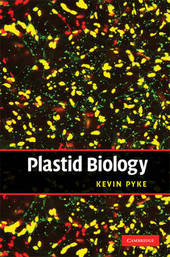
|
Plastid Biology
Hardback
Main Details
| Title |
Plastid Biology
|
| Authors and Contributors |
By (author) Kevin Pyke
|
| Physical Properties |
| Format:Hardback | | Pages:212 | | Dimensions(mm): Height 235,Width 158 |
|
| Category/Genre | Cellular biology (cytology)
Botany and plant sciences |
|---|
| ISBN/Barcode |
9780521885010
|
| Classifications | Dewey:571.659 |
|---|
| Audience | | Undergraduate | | Postgraduate, Research & Scholarly | |
|---|
| Illustrations |
3 Tables, unspecified; 36 Halftones, unspecified
|
|
Publishing Details |
| Publisher |
Cambridge University Press
|
| Imprint |
Cambridge University Press
|
| Publication Date |
30 April 2009 |
| Publication Country |
United Kingdom
|
Description
Plastids reside in all plant cells, and take on different forms in relation to their cellular function, biochemistry and storage capacity. The modern era of molecular biology and molecular genetics has enabled much to be learnt about how plastids function, and how they relate to their evolutionary past. In this accessible text, Kevin Pyke expertly describes how the plastids are highly complex organelles at the very core of plant cellular function, providing final year undergraduate and graduate students with an overview of plastid biology and recent developments in the field. Topics covered include: a consideration of different plastid types and how they relate to cell function; plastid genomes and how proteins are imported into plastids; photosynthesis and core aspects of plastid biochemistry; plastid signalling and functionality within a cellular context; and plastid genetic manipulation. Supplementary colour images are available online at www.cambridge.org/9780521885010.
Author Biography
Kevin Pyke has carried out research into various aspects of plastid biology over the past 25 years. He is Associate Professor in Plant Cell Biology in the Plant and Crop Sciences Division of the School of Biosciences, University of Nottingham. He has also worked at the John Innes Institute, Norwich, the University of York, and Royal Holloway, University of London. He identified an important collection of mutants in Arabidopsis in which chloroplast division was perturbed, which led to the identification of several novel genes functional in this process. More recently, he has worked on stromules and how they might enhance plastid function within the cell.
Reviews'There was much that I learned despite having worked in the field of photosynthesis and leaf metabolism for many years. Much about plastid morphology and development is well illustrated, with further colour images available as a zip-file online ... well-written, easy to read and is of potential interest to a wide audience, particularly now that there is renewed interest in improving photosynthesis to assure food security.' Annals of Botany
|